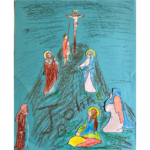
The full name of St. Catherine of Genoa was Caterina Fieschi Adorno, signifying her family surname and that of her husband, for Caterina was married. She was born in Genoa 1447, the youngest in a family of five children. Her father, Jacopo Fieschi and her mother Francesca di Negro, came from families of nobility. In fact the family was connected to two previous Popes and Jacopo was appointed Viceroy of Naples.
When Caterina was only 13 years old, perhaps following her sister’s example who had become an Augustinian nun, asked her confessor to apply on her behalf for entry into the Augustinian Monastery. She was refused because she was too young. She never tried to enter the monastery again.
When she was 16 years old, her father died. It was at this time that she was married to Giuliano Adorno, who had returned to Genoa after his travels to the Middle East where he was engaged in trade and military service. It was a marriage arranged by her brother most probably to bridge the feud between the two rival families. This marriage was a bitter experience for Caterina. They never had any children. Giuliano was far from being the ideal husband. He was a spendthrift besides being unfaithtful, a man characterized by outbursts of violent temper. Caterina was miserable, suffering in silence the tragedy of her marriage for five years. When she could not bear it any longer she started looking for alienation outside her marriage. After five years she had reached a point in her life when she started asking God for a sickness that would keep her in bed for the rest of her life.
She disclosed her sad state of mind and heart to her sister, the Augustinian nun, who encouraged her to approach the confessor of the nuns to receive the Sacrament of Reconciliation. During her confession she experienced “ an overpowering sense of God’s love for her.” Overwhelmed, she left the church without continuing with her confession.
This was her conversion.
Her life changed completely, becoming a life of continuous union with God, in prayer and penance, receiving Holy Communion almost daily, a practice not common in those days. She started to attend to the sick in a hospital in Genoa. This change in her life affected her husband’s way of life. He converted and he even became a Franciscan Tertiary besides joining her in her selfless, voluntary service to the sick. By this time Caterina and Giuliano were ruined financially as a result of Giuliano’s previous excessive spending. They decided to move and live in a large hospital, the Pammatone, dedicating their lives to the sick, that was heightened during the plague that ravished Genoa in 1496-97. After the death of her husband in 1497, she was appointed treasurer and manager of the hospital. At the same time she continued with her selfless dedication to the sick and to the needs of the hospital, consumed by her love of God.
She died on the 15th September 1510 after lingering on in suffering ‘hovering between life and death’ exhausted by her full dedication to the poor, the sick and the needy.













